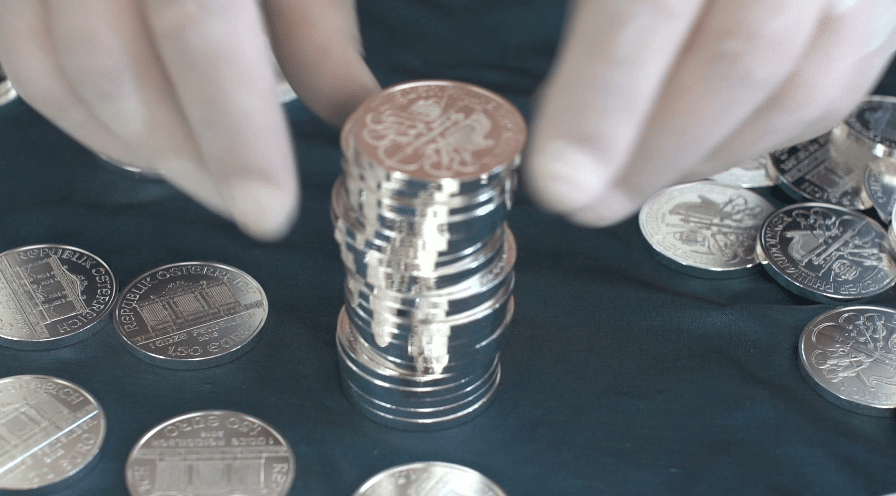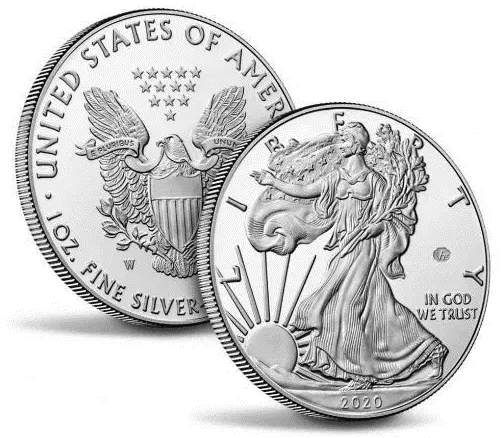What Is the Difference Between Silver Coins and Silver Bullion?

You're exploring a market where silver coins and silver bullion carve out two distinct pathways with their unique attributes and investment implications.
Silver coins, with their deep historical roots, not only offer intrinsic value from their metal content but also possess numismatic value, influenced by rarity, condition, and historical significance. This dual-value proposition can lead to potential appreciation over time, though it often comes with higher premiums and the unpredictability of demand. On the flip side, silver bullion is valued primarily for its metal content, closely tracking the spot price of silver, making it a more straightforward and stable investment option, less swayed by collector demand and offering easier liquidity. To better explain the key differences between silver coins and silver bullion, we will cover the following:
- Defining Silver Coins,
- Understanding Silver Bullion,
- Collectability and Value,
- Market Dynamics
- Investment Strategies
Understanding these differences sets the stage for a strategic approach to investing in silver, unlocking avenues for potential returns while navigating the nuanced dynamics of the silver market. As you move forward, you'll discover how these insights can guide your investment decisions for enhanced outcomes.

Defining Silver Coins
Silver coins, boasting a history that spans thousands of years across various civilizations, represent not only a form of legal tender but also a tangible piece of numismatic history. You're tapping into a legacy that traces back to the earliest days of currency, where these coins served as a cornerstone in trade and economy. The U.S. first minted its silver coins in 1791, embedding them deeply in the nation's monetary system. As legal tender, these coins carry the backing of the government, ensuring their acceptance in financial transactions.
The U.S. Mint, responsible for producing silver coins, ensures each piece meets stringent standards of purity and design. American Silver Eagles, for instance, contain 99.999% silver, making them among the purest forms of silver coins available. This high level of purity isn't just a benchmark for quality; it's a testament to the technological advancements and rigorous processes involved in coin minting today.
Diving into the numismatic aspect, silver coins aren't merely investments in precious metals; they're investments in history. Each coin tells a story, from its design to its journey through time. The 1794 Flowing Hair silver dollar, for example, isn't just valuable for its silver content but for its historical significance and rarity. However, it's crucial to understand that numismatic value is subject to fluctuations, influenced by market trends and collector demand.
In your journey through silver coinage, you're not just acquiring a piece of precious metal. You're investing in a legacy, where each coin is a chapter in the broader narrative of human civilization's economic evolution.
Understanding Silver Bullion
Diving into the realm of silver bullion, you'll find it's not just bars or ingots but a sophisticated investment option that demands a nuanced understanding of its purity, market value, and storage. Unlike silver coins, which often carry a legal tender status and can possess numismatic value, silver bullion is prized purely for its metal content, requiring investors to pay close attention to the market's fluctuating prices to maximize their return on investment.
When you're considering investing in silver bullion, the first aspect you'll need to grasp is purity. The market standard for bullion purity is typically between 99.5% to 99.9%. This high level of purity is crucial as it directly influences the bullion's market value and its acceptability among discerning investors. Unlike coins, which may derive part of their value from historical or collectible significance, bullion's value is intrinsically linked to the purity and weight of the silver it contains.
Next, understanding market value is essential. Silver bullion prices are closely tied to the spot price of silver, which fluctuates based on market demand, geopolitical stability, and economic indicators. As an investor, keeping a finger on the pulse of these changes helps you buy low and sell high, a principle that's at the heart of successful bullion investing.
Storage is another critical consideration. Unlike digital assets or stocks, silver bullion requires physical storage. Whether you opt for a home safe or a secure deposit at a facility, ensuring the safety and integrity of your investment from theft or damage is paramount. This aspect introduces additional costs and considerations, from insurance to secure transport, which you must factor into your overall investment strategy.
Collectability and Value
When assessing the collectability and value of silver investments, it's crucial to understand that not all pieces hold the same appeal or financial potential. Silver coins, for instance, carry both intrinsic and numismatic value, the latter being influenced by factors such as rarity, historical significance, and condition. The 1794 Flowing Hair silver dollar, a prized piece among collectors, exemplifies how numismatic value can far exceed the metal content's worth due to its historical importance and scarcity.
On the other hand, silver bullion, including bars, ingots, and rounds, primarily derives value from its silver content. Bullion items are valued closer to the current market price for silver, making them a more straightforward investment compared to silver coins. The premiums over the spot price for bullion are generally lower than those for coins because they lack legal tender status and, typically, numismatic value. However, some silver rounds feature creative designs that can attract collectors, though they do not have the legal tender value that coins possess.
Investing in silver coins offers the allure of potentially significant numismatic appreciation, but it also entails a higher initial premium and the risk of fluctuating collector demand. In contrast, silver bullion presents a more accessible entry point for those primarily interested in the metal's value, with less concern for collectability. Your choice between silver coins and bullion should align with your investment strategy, whether you're drawn to the thrill of numismatic collecting or prefer the stability of investing in silver's intrinsic value.
Market Dynamics
How do market dynamics influence the value of your silver investments, and what should you consider to optimize your portfolio? Understanding the interplay between supply, demand, and investor sentiment in the silver market is crucial. These factors not only affect the spot price of silver but also the premium over the spot price that you'll pay or receive for silver coins and bullion. To navigate these waters, you need a keen eye on market trends and an understanding of how different factors can sway your investments.
Here are three key points to consider:
- Supply and Demand Fluctuations:The basic economic principle of supply and demand plays a significant role in the price of silver. A surplus in silver production can depress prices, while a shortage can drive them up. For silver coins, limited mintages or special editions can create a higher demand among collectors, potentially increasing their value beyond the silver content.
- Economic Indicators:Silver prices are influenced by macroeconomic indicators such as inflation rates, currency values, and global economic stability. In times of economic uncertainty, investors often turn to silver as a safe haven, which can drive up prices. Keeping an eye on these indicators can help you anticipate market shifts.
- Investor Sentiment:The market's perception of silver's future value can significantly impact current prices. News, geopolitical events, and market speculation can lead to volatile swings in silver prices. Staying informed and understanding the mood of the market can give you an edge in timing your investments for optimal returns.
Best Silver and Gold IRA for Low Minimum Investment
Investment Strategies
To maximize your returns on silver investments, it's crucial to adopt a strategic approach that considers both market trends and the inherent characteristics of silver as an asset class. You must understand that silver, like any investment, requires a nuanced strategy to navigate its fluctuations and opportunities effectively.
Firstly, recognize the difference between silver coins and bullion. Silver coins, due to their numismatic value, often carry a premium over their metal content. This premium can fluctuate based on rarity, historical significance, and demand among collectors. Hence, investing in coins might suit you if you're keen on potentially higher returns tied to these factors, understanding that it entails a higher risk due to the variability of numismatic value.
On the other hand, silver bullion offers a more straightforward approach. Its value is primarily determined by the metal content, making it less susceptible to the whims of collectors' demand. It's an excellent choice for those looking to hedge against economic uncertainty or inflation, as bullion prices are more directly tied to market spot prices. This makes bullion a more stable, albeit less glamorous, investment.
Diversification within your silver portfolio can mitigate risks. Spread your investments across both coins and bullion to balance potential high returns from numismatic value with the stability of bullion. Additionally, keeping an eye on market trends and economic indicators can inform your buy or sell decisions, allowing you to better time the market.
Whether you are investing in silver bullion or coins, or both, working with a long-established and trusted precious metals IRA company can provide access to competitive prices, price transparency, a reasonable buyback policy, reliable customer service, and secure storage.
Depending on whether you are a high-net investor looking for the most competitive prices or require a lower investment minimum and affordable entry to the gold market, we have researched and reviewed our best 4 gold IRA and precious metal investment companies that meet those individual needs. Whether you prefer a gold IRA or owning the physical gold in your place of residence.
Tap the banner below to visit Augusta Precious Metals to receive their gold IRA checklist
Conclusion
In conclusion, you've seen that silver coins and bullion cater to different investment preferences. Coins offer a blend of historical allure and potential numismatic value, appealing to those who value rarity and storytelling. Bullion, on the other hand, provides a purer investment in silver's market value, attracting those seeking a straightforward metal investment. Understanding these nuances allows you to tailor your strategy, balancing collectability with market dynamics. Ultimately, your choice depends on your investment goals and the depth of your market knowledge.
Take Advantage of the Best Prices. Attend a Free Gold Investment Webinar for Investors with 100k or More to Protect
Find the right company for you. Obtain a gold IRA guide and talk to a broker




Gold IRA FAQs

Adam ONeill
Author, lifelong investor, and creator of PreciousMetalsInvestmentPortfolio.com


